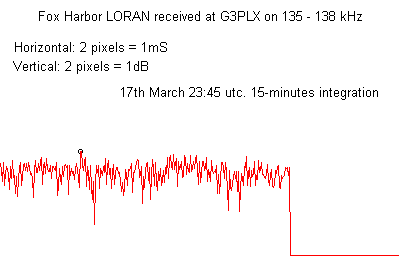
Return to KLUBNL.PL main page

| To: | [email protected] |
|---|---|
| Subject: | LF: TA Loran on 136 kHz |
| From: | [email protected] |
| Date: | Wed, 22 Mar 2006 18:02:05 EST |
| Delivered-to: | [email protected] |
| Reply-to: | [email protected] |
| Sender: | [email protected] |
|
Dear LF Group, a while ago, Peter G3PLX mentioned that it should be possible to receive American Loran sidebands on 136 kHz in time domain, focussing all the available power of the spectral lines back to short pulses. This is not quite easy as the expected average power within the SSB passband would be less than 50 mW EMRP, even for the strongest stations emitting a megawatt peak on 100 kHz. In addition, the wideband reception would make it difficult to evade QRM sources such as SXV, CFH or DCF39. Peter and I have both worked on software to do the time domain averaging, after rotating phases to align both to the group repetition interval (GRI) and to the one millisecond pulse repetition within the pulsegroups. To deal with frequency and samplerate deviations, we used different approaches: Peter applied his elegant GPS-based "ClickLock" technique which he described in another posting, whereas I attempted to aquire and track the stronger European chains (Sylt, Eide) and derive absolute TAI time, and then look only around the expected pulse arrival times of the other chains. Last Friday, Peter recorded this graph, showing the first positive reception of transatlantic Loran spillover on 136 kHz, with a peak of about 15 dB SNR: ____________________________________________________________  ____________________________________________________________ The same night, my modified "LoranView" program managed to pick up the Saudi Arabia chain (GRI 8830), but no definite TA reception yet. This screenshot is from 21:56 to 22:56, with 5 minutes/pixel vertically and 5513 samples/s left to right:  However the next night produced clear traces of several North American stations - http://people.freenet.de/df6nm/LoranView/LoranView_137and100kHz.htm shows time-domain Loran as seen on 136.75 kHz and on 100 kHz. In general, relative levels of the 100 kHz main signal and the 136 kHz sidebands seem to be more or less the same for all stations, with the notable exeption of Simferopol which has unusually high spillover. Shown alongside is a small colour-DF spectrogram of the LF band occupation; obviously most of the noise background is associated with SXV (yellow on 135.73 kHz) and CFH (blue on 137.0 kHz). 73 and best wishes Markus In einer eMail vom 02.03.2006 21:24:07 Westeuropäische Normalzeit schreibt [email protected]: Re: LF: LORAN spurious emission levels ... I have now extended the coherent software so I can receive the spurious LORAN signals as pulses. This is about 25dB more sensitive that looking for a single spectral line, because I am effectively adding-together ALL the spurious spectral lines I can hear in the 3kHz SSB receiver. I can, for example, copy the Slonim (Belarus) LORAN transmitter, 1800km away, at midday, on 136.5kHz in a bandwidth of +/-1.5kHz. It's 20dB/noise, but of course that is after 15 minutes of coherently summing the signal. The nice thing about this technique is that the different transmitters in the chain do NOT mix together. I can even read the 8-bit BPSK ident code inside each pulse - the modulation on the spurious emissions is still perfectly readable. Maybe I could even copy some of the USA LORAN transmitters on 136kHz using this idea. No more need for beacons, just record the dx LORAN pulses! |
| <Prev in Thread] | Current Thread | [Next in Thread> |
|---|---|---|
| ||
| Previous by Date: | LF: portable DX-pedition antenna?, Dick |
|---|---|
| Next by Date: | Re: LF: portable DX-pedition antenna?, Mike Dennison |
| Previous by Thread: | LF: T/A Mar, 21/22, Hartmut Wolff |
| Next by Thread: | LF: majordomo, m0fmt |
| Indexes: | [Date] [Thread] [Top] [All Lists] |